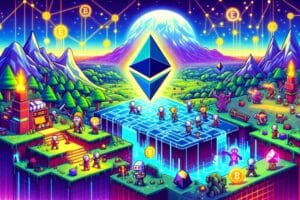The new frontier of Gaming on Blockchain has transformed the entire industry into a global phenomenon, making profits very high.
Blockchain Gaming: the advantages of this innovation
For millennia, humanity has found entertainment in games, from ancient practices of fists and dice to modern Minecraft and Fortnite.
With the advent of digital technology, video games have become a global phenomenon, giving rise to a multibillion-dollar industry.
But as technology progresses, another innovation – the blockchain – looms on the horizon, promising to revolutionize the way players interact and participate in the gaming experience.
In an era where blockchain aims to transform multiple sectors, from the economy to healthcare, the world of video games seems to have remained relatively unchanged.
However, the idea of bringing games “on-chain”, that is, on the blockchain, is gaining more and more attention and interest. But why should we consider this transition?
One of the main promises of blockchain is its transparency and immutability. Being a public and distributed ledger, every operation on it is recorded permanently.
This eliminates deceptive practices and fraud, offering a more fair and secure gaming environment. The rules of the game itself can be encoded in smart contracts, allowing players to examine and ensure the fairness of the process.
Unlike traditional gaming platforms that are often isolated from each other, blockchains offer the possibility of unprecedented interoperability between games.
With cross-chain bridges, players can easily migrate their accounts and assets from one blockchain to another.
This paves the way for a more fluid and connected ecosystem, where players can enjoy seamless gaming experiences.
Opportunities for Blockchain-based Gaming Economies
Online gaming ecosystems have already shown that they can generate significant internal economies.
However, with the integration of blockchain, these economies can reach even more sophisticated levels. Tokenized assets allow for greater liquidity and fungibility of gaming items, while smart contracts enable the creation of decentralized financial systems within the games themselves.
Despite these promises, there are still obstacles to overcome. Many of the most popular online games require processing power and low latency that current blockchains may not be able to guarantee.
However, with the continuous development of blockchain technology, it is likely that these issues will be addressed over time.
Currently, there are several approaches to creating on-chain games. Some games tokenize in-game items, allowing players to truly own what they earn in the game.
Others fully integrate the gaming experience on the blockchain, offering gameplay and interactions directly on the chain itself. Some notable examples include games like Gods Unchained, Axie Infinity, and Illuvium.
Furthermore, the on-chain gaming market is growing rapidly, with more and more developers and publishers diving into this space.
While some may consider this transition as a natural step forward in the evolution of gaming, others may remain skeptical about potential technical and adoption issues.
Conclusions
In conclusion, on-chain games represent a new frontier in the gaming industry, offering unprecedented transparency, interoperability, and economic opportunities.
Although there are still challenges to face, the potential of this sector is enormous and definitely deserves the attention of gaming enthusiasts and investors alike.









